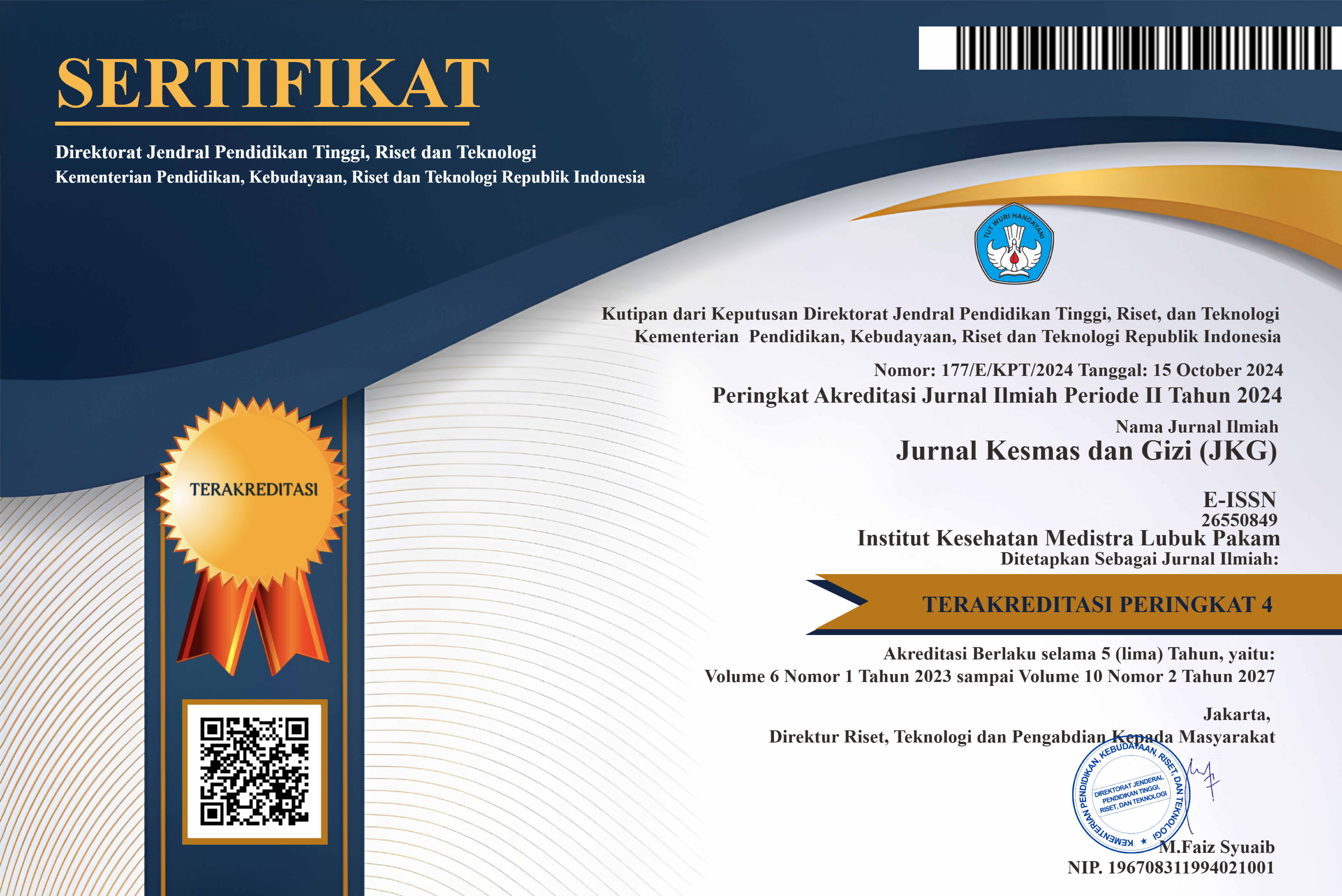The Relationship Of Exclusive Breastfeeding With Stunting Incidents In Toddler In Dt Village
DOI:
https://doi.org/10.35451/jkg.v6i2.2147Keywords:
Exclusive Breastfeeding and StuntingAbstract
Stunting or short stature is a serious nutritional problem that is currently of concern to the Indonesian government because it has a negative impact on reducing the quality of human resources in the future. Indonesia is the country with the fifth largest incidence of stunting out of 88 countries in the world and the third highest after Timor Leste and Democratic Laos in the South-East Asia Regional (SEAR) region, with stunting sufferers of 7.8 million or 35. 65%. Exclusive breastfeeding is one of the factors that can influence the prevalence of stunting because the nutrition contained in breast milk is an important factor that determines a child's growth and development. The aim of this research was to determine the relationship between exclusive breastfeeding and the incidence of stunting in toddlers in Dolok Tolong Village, Sumbul District, Dairi Regency. The research design used was an analytical survey with a cross-sectional study design. The sample was 38 toddlers. The results obtained were that the majority of the samples were aged 11-20 months (21.1%), 26 toddlers who were not given exclusive breastfeeding (68.4%), and 9 toddlers (23.7%) were included in the stunting category. Based on the test results statistics using the chi square correlation test, the results showed that there was a significant relationship between exclusive breastfeeding and the incidence of stunting (p=0.002). It is hoped that the results of this research can contribute to related parties, especially Community Health Centers, regarding exclusive breastfeeding to overcome stunting
Downloads
References
Aryastami, N. K. (2017). Kajian Kebijakan dan Penanggulangan Masalah Gizi Stunting di Indonesia. Buletin Penelitian Kesehatan, 45(4), 233–240. https://doi.org/10.22435/bpk.v45i4.7465.233-240
Cetthakrikul, N., Topothai, C., Suphanchaimat, R., Tisayaticom, K., Limwattananon, S., & Tangcharoensathien, V. (2018). Childhood stunting in Thailand: When prolonged breastfeeding interacts with household poverty. BMC Pediatrics, 18(1), 1–9. https://doi.org/10.1186/s12887-018-1375-5
Hadi, H., Fatimatasari, F., Irwanti, W., Kusuma, C., Alfiana, R. D., Ischaq Nabil Asshiddiqi, M., Nugroho, S., Lewis, E. C., & Gittelsohn, J. (2021). Exclusive breastfeeding protects young children from stunting in a low?income population: A study from eastern indonesia. Nutrients, 13(12), 1–14. https://doi.org/10.3390/nu13124264
Karo, M. . (2021). Perilaku ibu menyusui dalam pemberian ASI eksklusif. Penerbit NEM.
Kartiningrum, E. D. (2019). Faktor Risiko Kejadian Gizi Kurang Pada Balita Di Desa Gayaman Kecamatan Mojoanyar Mojokerto. Hospital Majapahit (JURNAL ILMIAH KESEHATAN POLITEKNIK KESEHATAN MAJAPAHIT MOJOKERTO), 7(2), 67–80. https://doi.org/10.55316/hm.v7i2.112
Kemenkes. (2019). Kementerian Kesehatan Republik Indonesia. Kementerian Kesehatan RI, 1(1), 1. https://www.kemkes.go.id/article/view/19093000001/penyakit-jantung-penyebab-kematian-terbanyak-ke-2-di-indonesia.html
Kemenkes. (2023). Profil Kesehatan Indonesia 2022. Kementerian Kesehatan RI.
Kemenkes RI. (2018). Buletin Stunting. Kementerian Kesehatan RI, 301(5), 1163–1178.
Kemenkes RI. (2022). Status Gizi SSGI 2022. Kemenkes RI, 1–156.
Kemensesneg RI. (2022). WHO: ASI Eksklusif adalah kunci penurunan stunting di Indonesia. https://stunting.go.id/who-asi-eksklusif-adalah-kunci-penurunan-stunting-di-indonesia/
Kementerian PPN. (2020). Pedoman Teknis Penyusunan Rencana Aksi - Edisi II Tujuan Pembangunan Berkelanjutan/ Sustainable Development Goals (TPB/SDGs). Kementerian PPN.
Masitoh, S. (2022). BKKBN: Rokok Jadi Faktor Indoensia Duduki Posisi 108 Stunting di Dunia. https://nasional.kontan.co.id/news/bkkbn-rokok-jadi-faktor-indoensia-duduki-posisi-108-stunting-di-dunia
Rachmayanti, D. R. (2022). Pemberian ASI Eksklusif sebagai faktor protektor pada resiko stunting. https://unair.ac.id/pemberian-asi-ekslusif-sebagai-faktor-protektor-pada-resiko-stunting/#:~:text=Selain itu beberapa hasil penelitian,yang tidak mendapatkan ASI Eksklusif.
Rhisma Nasita Sianti, Martha Irene Kartasurya, & Apoina Kartini. (2024). Can Exclusive Breastfeeding Prevent Stunting in Lower Middle-Income Countries (LMIC)?: A Systematic Review. International Journal of Integrative Sciences, 3(1), 37–58. https://doi.org/10.55927/ijis.v3i1.7417
Rokom. (2023). Prevalensi Stunting di Indonesia Turun ke 21,6% dari 24,4%. https://sehatnegeriku.kemkes.go.id/baca/rilis-media/20230125/3142280/prevalensi-stunting-di-indonesia-turun-ke-216-dari-244/
Trihono, Atmarita, Tjandrarini, D. H., Irawati, A., Utami, N. H., Tejayanti, T., & Nurlinawati, I. (2015). Pendek (Stunting) di Indonesia, Masalah dan Solusinya. Badan Penelitian dan Pengembangan Kesehatan (Balitbangkes) Kemenkes RI.
Downloads
Published
Issue
Section
License
Copyright (c) 2024 Sri Melda Br Bangun, Julita Rotua Sihombing

This work is licensed under a Creative Commons Attribution 4.0 International License.
Copyright in each article is the property of the Author.


























